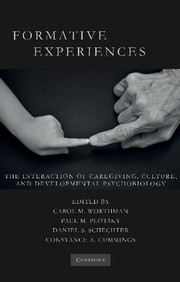Book contents
- Frontmatter
- Contents
- List of Figures
- List of Tables
- List of Contributors
- Foreword by Robert Sapolsky
- Preface
- List of Abbreviations
- Introduction
- SECTION ONE HISTORICAL, CROSS-CULTURAL, AND DEVELOPMENTAL SCIENCE PERSPECTIVES
- 1 Plasticity and Variation: Cultural Influences on Parenting and Early Child Development Within and Across Populations
- 2 From Measurement to Meaning in Caregiving and Culture: Current Challenges and Future Prospects
- SECTION TWO HOW EXPERIENCE INTERACTS WITH BIOLOGICAL DEVELOPMENT
- SECTION THREE FORMATIVE RELATIONSHIPS WITHIN AND ACROSS GENERATIONS
- SECTION FOUR SOCIAL AND CULTURAL CONTEXTS OF CHILDHOOD DEVELOPMENT – NORMATIVE SETTINGS, PRACTICES, AND CONSEQUENCES
- SECTION FIVE FEAR, FUN, AND THE BOUNDARIES OF SOCIAL EXPERIENCE
- SECTION SIX PUBLIC HEALTH, EDUCATION, AND POLICY IMPLICATIONS
- Index
- References
1 - Plasticity and Variation: Cultural Influences on Parenting and Early Child Development Within and Across Populations
Published online by Cambridge University Press: 26 May 2010
- Frontmatter
- Contents
- List of Figures
- List of Tables
- List of Contributors
- Foreword by Robert Sapolsky
- Preface
- List of Abbreviations
- Introduction
- SECTION ONE HISTORICAL, CROSS-CULTURAL, AND DEVELOPMENTAL SCIENCE PERSPECTIVES
- 1 Plasticity and Variation: Cultural Influences on Parenting and Early Child Development Within and Across Populations
- 2 From Measurement to Meaning in Caregiving and Culture: Current Challenges and Future Prospects
- SECTION TWO HOW EXPERIENCE INTERACTS WITH BIOLOGICAL DEVELOPMENT
- SECTION THREE FORMATIVE RELATIONSHIPS WITHIN AND ACROSS GENERATIONS
- SECTION FOUR SOCIAL AND CULTURAL CONTEXTS OF CHILDHOOD DEVELOPMENT – NORMATIVE SETTINGS, PRACTICES, AND CONSEQUENCES
- SECTION FIVE FEAR, FUN, AND THE BOUNDARIES OF SOCIAL EXPERIENCE
- SECTION SIX PUBLIC HEALTH, EDUCATION, AND POLICY IMPLICATIONS
- Index
- References
Summary
This chapter examines two moments in the twentieth century when anthropology made a major contribution to developmental research or was in a position to do so. I seek to clarify what progress has been made up to now and discern what can be done to find a way forward.
The question of whether anthropology can make a central contribution to our understanding of human development has been asked – and answered affirmatively – at least since Margaret Mead (1928, 1930, 1931) raised it in the first third of the 20th century, and numerous times since then by the Whitings (e.g., J. Whiting, 1954; Whiting & Whiting, 1960) and others, including several contributors to this volume. Forceful arguments, vivid illustrations, and empirical evidence have been assembled – repeatedly, recently as well as in the past, and in interdisciplinary forums – to argue the necessity of cross-cultural research on childhood environments and development for a science of human child development and, more specifically, for developmental psychology and psychiatry. Is there any need to make this case again?
Apparently so. All the evidence I am aware of suggests that even in this first decade of the 21st century, with the exception of nutritional science, anthropological, and other cross-cultural studies remain marginal to and of minor significance in the mainstreams of the research disciplines investigating child development (developmental psychology, child psychiatry, pediatrics, and education).
- Type
- Chapter
- Information
- Formative ExperiencesThe Interaction of Caregiving, Culture, and Developmental Psychobiology, pp. 11 - 35Publisher: Cambridge University PressPrint publication year: 2010
References
- 2
- Cited by



